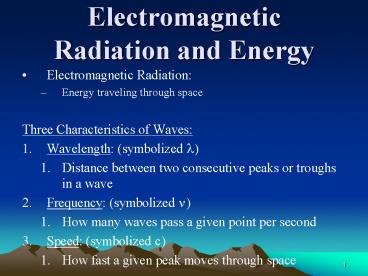Electromagnetic Radiation and Energy - PowerPoint PPT Presentation
1 / 15
Title:
Electromagnetic Radiation and Energy
Description:
Electromagnetic Radiation and Energy Electromagnetic Radiation: Energy traveling through space Three Characteristics of Waves: Wavelength: (symbolized l) – PowerPoint PPT presentation
Number of Views:311
Avg rating:3.0/5.0
Title: Electromagnetic Radiation and Energy
1
Electromagnetic Radiation and Energy
- Electromagnetic Radiation
- Energy traveling through space
- Three Characteristics of Waves
- Wavelength (symbolized l)
- Distance between two consecutive peaks or troughs
in a wave - Frequency (symbolized n)
- How many waves pass a given point per second
- Speed (symbolized c)
- How fast a given peak moves through space
2
(No Transcript)
3
Electromagnetic Radiation and Energy
- c ? x ?
- c speed of particle
- speed of light 2.9979 x 108 m/s
- ? frequency (s-1 or Hz)
- ? wavelength (m)
4
(No Transcript)
5
- As temperature increases
- Maximum energy released in visible spectrum goes
towards UV - white hot
6
Einsteins Photon
- Photoelectric effect
- Electron ejection after light strikes metal
surface - Must be the right frequency
- Used in automatic door openers
- Einstein
- Light has particle-like properties
- Photons
- No longer viewed as purely a wave
7
Spectra
- Sunlight yields continuous spectrum
- Energized gaseous elements yield certain
wavelengths - Line emission spectrum
8
Atomic orbital
- The probability function that defines the
distribution of electron density in space around
the atomic nucleus.
9
The s-orbital
- The simplest orbital
- The only orbital in the s-subshell
- Occurs in every principal energy level
- s stands for sharp
- The first energy level only houses this orbital
- Can house up to 2 electrons
10
The p-orbitals
- Start in second principle energy level (n2)
- There are three p-orbitals in the p-subshell (see
below) - And one s-orbital
- p stands for principle
- Can house up to 6 electrons
- 2px 2py 2pz
11
The d-orbitals
- Start in third principle energy level (n3)
- There are five d-orbitals in the d-subshell
- And one s-orbital
- And three p-orbitals
- Can house up to 10 electrons
- d stands for diffuse
- 3dyz 3dxz
3dxy 3dx2-y2 3dz2
12
The f-orbitals
- Start in fourth principle energy level (n4)
- There are seven f-orbitals in the f-subshell
- And one s-orbital
- And three p-orbitals
- And five d-orbitals
- Can house up to 14 electrons
- f stands for fundamental
13
(No Transcript)
14
Electron Configuration
- Explain reactivity (or lack thereof) of elements
- Explains order of placement in Periodic Table
- Into groups or families
- Similar chemical physical properties
15
Using the Periodic Table to advantage

